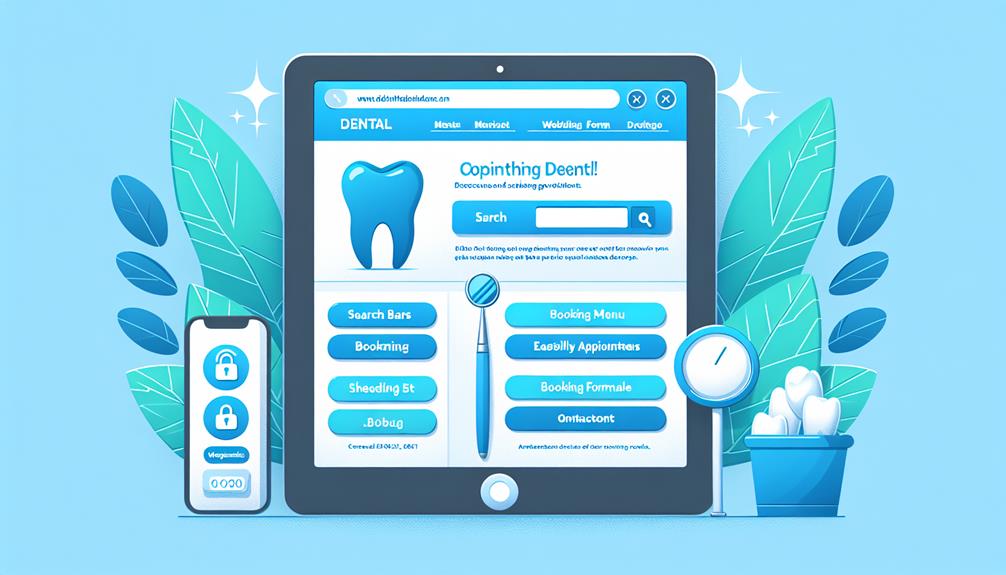Did you know that 88% of online consumers are less likely to return to a site after a bad user experience?
When it comes to dental websites, optimizing user experience (UX) is not just about aesthetics—it can significantly impact your search engine optimization (SEO) efforts.
From site speed to mobile responsiveness, navigation, content quality, and more, there are seven key UX elements that play a crucial role in boosting your website’s visibility and ranking.
Understanding how these elements intertwine with SEO can make or break your online presence.
Key Takeaways
- Fast loading times and mobile responsiveness are crucial for user satisfaction, retention, and SEO performance on dental websites.
- Clear and concise navigation structures with intuitive menu labels enhance user engagement and SEO optimization.
- High-quality, keyword-optimized content with relevant internal linking improves user experience and search engine visibility for dental websites.
- Strategic placement of CTAs, effective linking strategies, and user-friendly navigation contribute to enhanced conversion rates and SEO performance on dental websites.
Site Speed
To enhance the user experience and improve search engine rankings for dental websites, optimizing site speed is crucial. Loading time plays a significant role in user satisfaction and retention. When pages load quickly, visitors are more likely to stay, engage with the content, and ultimately convert.
Slow loading times can lead to high bounce rates, negatively impacting SEO efforts. Page optimization is key to reducing loading times. By compressing images, minifying CSS and JavaScript files, and leveraging browser caching, you can significantly improve site speed.
Google’s algorithm considers site speed as a ranking factor, making it essential for dental websites to prioritize this aspect. A fast-loading website not only enhances user experience but also signals credibility and professionalism to visitors. In a competitive online landscape, every second counts.
Mobile Responsiveness
Improving mobile responsiveness on dental websites is crucial for enhancing user experience and boosting SEO rankings. A website that adapts seamlessly to various screen sizes ensures that visitors can easily navigate your site, find information, and contact your dental practice. In today’s mobile-driven world, a mobile-friendly website is not just a luxury but a necessity.
When considering mobile responsiveness, it’s essential to focus on optimizing the website layout for smaller screens. A cluttered or disorganized layout can frustrate users and lead to high bounce rates. By designing a clean and intuitive layout, users can quickly locate the information they need, such as services offered, contact details, and appointment scheduling.
To emphasize the importance of mobile responsiveness further, let’s take a look at the following emotional impact table:
| Emotion | Mobile-Friendly Website | Non-Mobile-Friendly Website |
|---|---|---|
| Frustration | Low | High |
| Satisfaction | High | Low |
| Engagement | High | Low |
Ensuring mobile responsiveness not only enhances user experience but also positively impacts your dental website’s SEO performance.
Navigation and Menu Structure
When optimizing your dental website, ensure your navigation is user-friendly with clear menu labels and easy-to-access buttons. Mobile-friendly navigation is crucial for enhancing the user experience and improving search engine optimization.
Clear Menu Labels
Clear and intuitive menu labels play a crucial role in enhancing user experience and facilitating smooth navigation on dental websites. When designing your website’s menu, consider the following to optimize user engagement and information architecture:
- Simplicity: Keep menu labels concise and clear to avoid confusion.
- Relevance: Ensure menu labels accurately represent the content they lead to.
- Consistency: Maintain a uniform style and structure throughout all menu labels.
- Hierarchy: Organize menu labels in a logical order to assist users in finding information easily.
Mobile-Friendly Navigation
In optimizing mobile-friendly navigation on dental websites, it’s essential to ensure seamless user interaction through a responsive menu structure. User experience is greatly influenced by how easy it’s to navigate your site on a mobile device.
Conduct usability testing to ensure that the menu is intuitive and easy to use, allowing visitors to find information quickly. A clear and concise menu structure enhances user experience, leading to higher engagement and better SEO performance.
Prioritize simplicity and clarity in your navigation design, focusing on easy access to key information. By optimizing mobile-friendly navigation with user experience and usability testing in mind, you can create a website that not only ranks well but also provides a positive experience for visitors.
Content Quality and Relevance
Enhancing the quality and relevance of content on dental websites is crucial for optimizing SEO performance and engaging visitors effectively. When it comes to content strategy, every word matters. Here’s how you can ensure your dental website’s content is top-notch:
- Keyword Optimization: Conduct thorough keyword research to understand what terms your potential patients are searching for.
- User Experience: Craft content that’s easy to read, visually appealing, and provides value to the reader.
- Relevant Information: Ensure your content is up-to-date, accurate, and addresses common dental concerns and questions.
- Internal Linking: Strategically link related content within your website to improve navigation and establish topical authority.
Call-to-Action (CTA) Placement
Optimize your dental website’s performance by strategically placing Call-to-Action (CTA) buttons to drive visitor engagement and conversions efficiently. Effective CTA positioning is critical for conversion optimization. Consider placing CTAs where they’re easily visible, such as at the top of the page or after key sections of content. By strategically positioning CTAs throughout your website, you guide visitors on the desired path, increasing the likelihood of conversion.
When deciding on CTA placement, think about the user’s journey on your website. Analyze which pages receive the most traffic and where visitors spend the most time. By placing CTAs strategically on these high-traffic and high-engagement pages, you can capitalize on user interest and drive conversions effectively.
Forms and Contact Information
How can strategically placing forms and contact information on your dental website enhance user engagement and facilitate communication with potential patients?
When it comes to conversion optimization and user experience, the placement of forms and contact details is crucial. Here’s how you can strategically utilize these elements:
- Lead Generation: By strategically placing lead capture forms on your website, you can generate valuable leads for your dental practice.
- User Engagement: Providing easily accessible contact information encourages users to reach out and engage with your practice.
- Conversion Optimization: Well-placed forms can guide visitors towards taking desired actions, such as booking appointments or requesting more information.
- Improved Communication: Clear contact information makes it easier for potential patients to get in touch, leading to better communication and relationship-building opportunities.
Visual Design and Branding
Strategically aligning visual design elements with your branding on your dental website can establish a cohesive and professional online presence. When it comes to color psychology, select colors that resonate with your brand identity and evoke the right emotions in your visitors. Warm tones like blues and greens can convey trust and calmness, ideal for a dental practice.
Typography plays a crucial role in conveying your brand message effectively. Choose fonts that are easy to read and align with the tone of your practice, whether it’s modern and sleek or traditional and reliable.
Logo placement is key in reinforcing brand recognition. Ensure your logo is prominently displayed on your website, preferably in the header for maximum visibility. Imagery choices should also reflect your brand values. Use high-quality images that showcase your practice, team, and services to create a professional impression.
Consistent branding across all visual elements on your website won’t only enhance user experience but also strengthen your SEO efforts by establishing a recognizable online identity.
Frequently Asked Questions
How Can User Experience Elements on a Dental Website Affect Its Search Engine Ranking?
To improve search engine ranking for a dental website, focus on user experience elements. Ensure mobile responsiveness and fast load times. Streamline navigation and optimize call-to-action buttons. Prioritize a seamless user journey to enhance SEO performance and attract more visitors.
Are There Specific Design Elements That Can Improve SEO for Dental Websites?
Improving SEO on dental websites involves optimizing mobile responsiveness and navigation for better user experience. Strategic color schemes and imagery can enhance engagement. A study found that 57% of users won’t recommend a poorly designed site.
How Can Optimizing UX Elements on a Dental Website Lead to Increased Traffic and Conversions?
Optimizing UX elements on your dental website can significantly boost traffic and conversions. Enhancing user engagement and focusing on conversion optimization through a seamless user journey and mobile responsiveness are key strategies for success.
What Role Do User Behavior Metrics Play in the SEO Performance of Dental Websites?
You’ve probably heard that user behavior metrics are crucial for SEO on dental websites. Click through rates, bounce rates, dwell time, and conversion rates all impact how search engines perceive your site. Keep monitoring and improving them!
Are There Any UX Best Practices That Are Unique to Dental Websites Compared to Other Industries?
In the realm of dental websites, certain UX practices stand out. Mobile responsiveness and user engagement are key for accessibility. Visual hierarchy and trust indicators are vital for credibility. Implementing these unique strategies can enhance user experience and boost SEO performance.
Conclusion
In conclusion, optimizing these 7 UX elements on your dental website is like fine-tuning a symphony – each component plays a crucial role in harmonizing the user experience and boosting SEO performance.
By prioritizing site speed, mobile responsiveness, navigation, content quality, CTA placement, forms, and visual design, you can create a seamless journey for visitors while also improving your search engine rankings.
Remember, a well-crafted website is the key to hitting all the right notes in the digital landscape.

Suraj Rana is a renowned Dental SEO Expert, deeply committed to elevating dental practices in the online landscape. With a profound understanding of technical SEO, he specializes in tailoring on-page optimization strategies specifically for the dental industry. Suraj’s extensive experience spans across various sectors, but his passion truly lies in transforming the digital presence of dental clinics. His expertise in dental-specific search engine optimization, combined with a data-driven approach, empowers him to develop strategies that significantly increase organic traffic, enhance search engine rankings for dental-related keywords, and ultimately drive business growth for his dental clients. Suraj Rana’s unique blend of SEO skills and dedication to the dental field make him an invaluable asset to any dental practice looking to thrive online.


